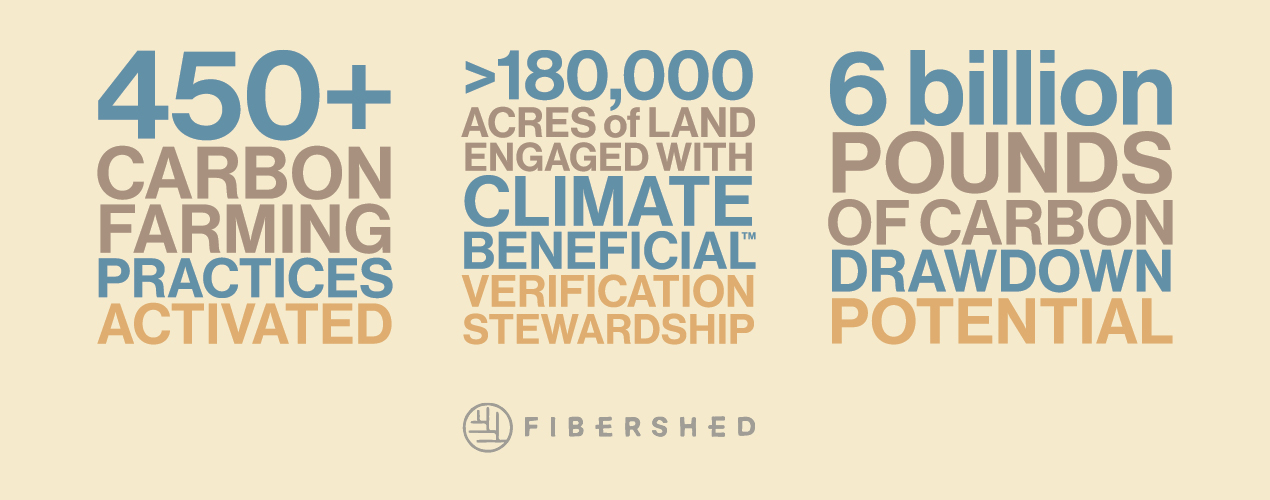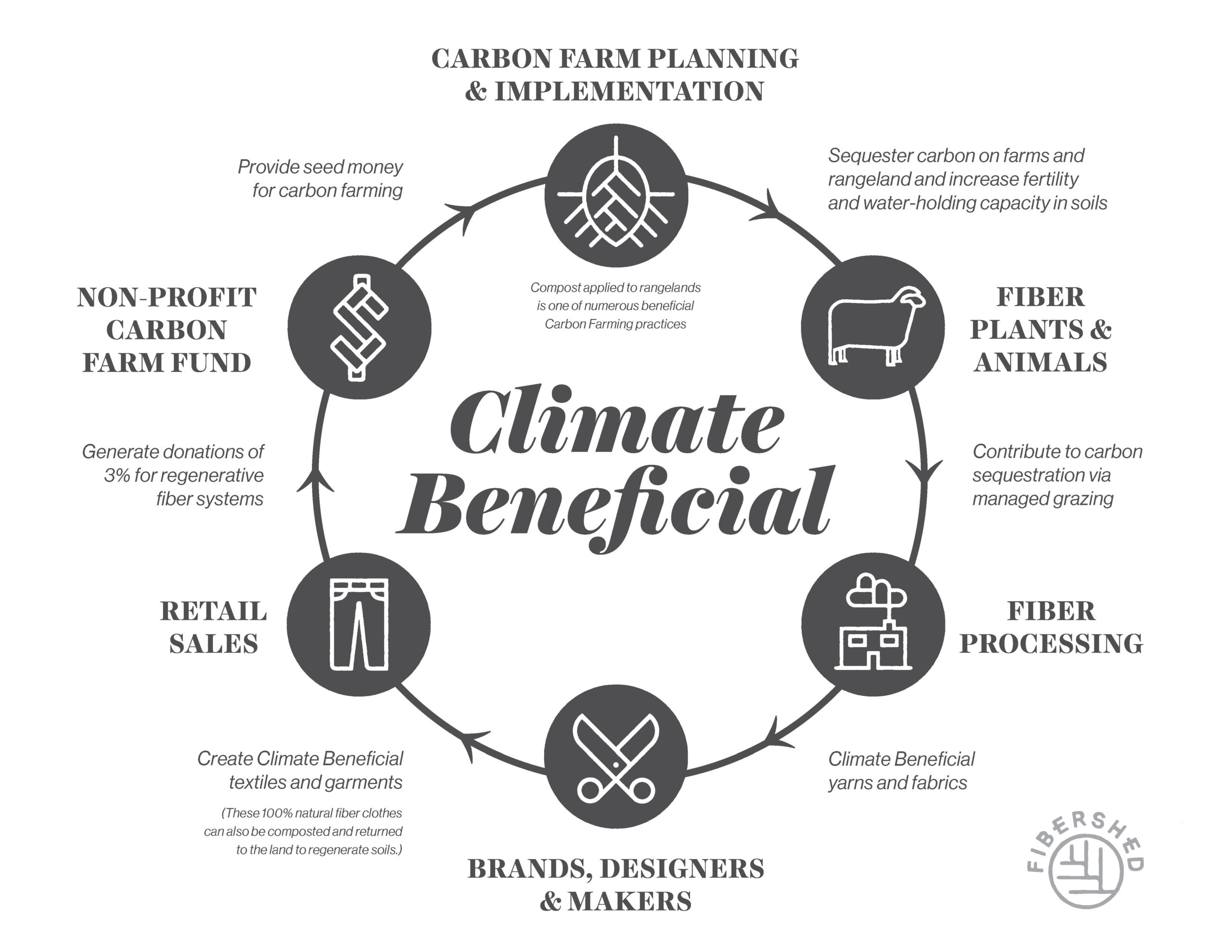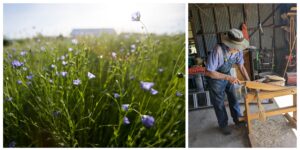Climate Beneficial™ Verification Program
![]()
Natural fibers like wool, cotton, alpaca, and flax linen can be grown and raised in ways that maximize the drawdown of carbon from the atmosphere to help restore ecosystem health and stabilize our climate.
Fibershed’s Climate Beneficial™ Verification program and label supports farmers and ranchers in landscape level stewardship that centers their work to build healthy soil. Developed in 2015 in collaboration with The Carbon Cycle Institute, scientists, and technical service providers, our Climate Beneficial™ Program engages fiber producers and provides financial and technical support to enhance the drawdown of carbon from the atmosphere. Impact to the climate is measured using a combination of direct soil measurement, computer modeling via dynamic environmental systems models, as well as localized peer reviewed data from our region’s land grant universities.
By connecting producers with designers and markets that value ecosystem services, we can grow materials and supply chains rooted in verified practices that:
- Increase Soil Organic Carbon levels
- Enhance biodiversity by providing habitat for pollinators, birds, and many species
- Improve the water-holding capacity of the soil
- Restore healthy ecosystems, from the soil microbiome to nutrient cycles
- Provide measurable climate benefits, quantified by open-source data tools
Choosing Climate Beneficial verified fiber connects your garment or durable good directly to practices that regenerate soil carbon, and so much more.

How Our Practice-Based Verification Works:
Climate Beneficial fiber production regenerates working landscapes through carbon farm planning and implementation. Fibershed designed the Climate Beneficial Verification to support and increase adoption of carbon farming practices on fiber and dye producing landscapes.
- We work directly with producers in Northern California to provide education and support for adopting practices
- We verify carbon farming practices every year on participating producer landscapes
- We partner with agriculture experts and technical service providers to develop Carbon Farm Plans for participating producers
- We develop markets for Climate Beneficial Verified fiber by sharing educational information with the public, with fashion and textile designers and brands, and by connecting producers to buyers
- We expand support for producers to actualize Carbon Farm Plans by working with policymakers, connecting producers to public funding, and raising and issuing funds directly through the Carbon Farm Seed Fund
- We focus our verification process within the Northern California Fibershed, and we collaborate with peer communities through our Fibershed Affiliate Network to develop place-based verification systems
- We are currently expanding the Climate Beneficial Program within Northern and Central CA and to three other regions across the United States thanks to a USDA Climate Smart Commodities grant
To become Climate Beneficial Verified:
Producer Enrolls
All farmers and ranchers who are members of Fibershed’s Producer Network are eligible to enroll in our Climate Beneficial Program. Producers first fill out an Entrance Survey, where they describe their current operations, goals and motivations for joining the Climate Beneficial Program, and experience with carbon farming practices.
Soil Benchmarking
We then schedule a time to meet on site, discuss your operations in greater detail, and begin to assess opportunities for increased carbon capture. We take soil samples to establish a baseline for soil organic carbon and bulk density and conduct more extensive soil tests with some of our larger growers based on University partnerships.
Carbon Farm Practice Implementation and Reporting
Producers annually implement carbon farming practices and report the details of their practices to us. Practice implementation data is used to calculate estimations for the climate impact of each practice using regional peer-reviewed research and/or COMET Planner, an open source carbon drawdown modeling tool. Carbon metrics for each farm and ranch are aggregated and tracked in a backend data-base, which allows us to provide up to date greenhouse gas measurements to our partners who are utilizing Climate Beneficial fiber.
Carbon Farm Planning
To become fully Climate Beneficial Verified, producers have a formal Carbon Farm Plan written for their land and operations. This is a comprehensive planning process developed by the Carbon Cycle Institute that involves farm and ranch soil mapping, site analysis, an extensive evaluation of all potential opportunities for additional carbon capture, and quantification of the carbon impacts of these potential practices. We connect producers to their local Resource Conservation District, where a technical service provider can often work with them to write a Carbon Farm Plan.
The Carbon Farm Plan functions as a road map for land stewards to follow. Each year producers operationalize their Carbon Farm Plan and implement new beneficial carbon farming practices and provide continual improvement on existing practices.

Join Us In Landscape-Level Change
Select Climate Beneficial Verified items for your next clothing or textile purchase: find farm-fresh goods in the cooperative Fibershed Marketplace, and find links to specific artisans and brands here.
Source Climate Beneficial fiber for your clothing or home goods: independent designers and brands can learn more about Climate Beneficial Fibers and sourcing here.
Start your journey into Climate Beneficial Verification: fiber and dye producers are invited to join our Northern California Producer Network and ask for more information about the Climate Beneficial pipeline
Support a resilient climate and ecosystem restoration with a contribution to the Carbon Farm Seed Fund, which goes directly to on-farm practices.
Learn more about Climate Beneficial verified fibers
as covered by Fashionista, Fast Company, Capital Public Radio, Vogue Magazine

“Climate Beneficial” is a registered trademark of Fibershed. Participating producers, brands, and designers can find Fibershed’s use guidelines here: Climate Beneficial Blending and Supply Chain Parameters.
Photos by Paige Green



